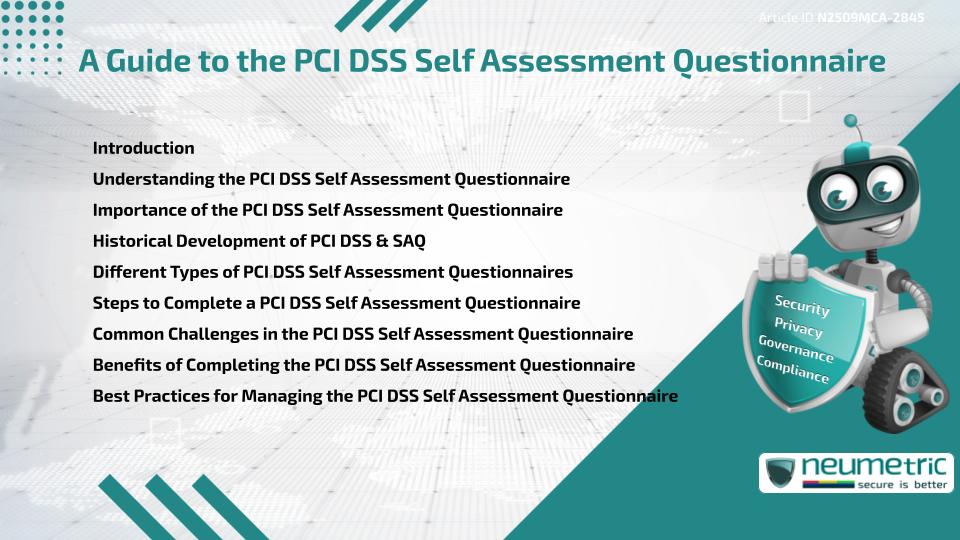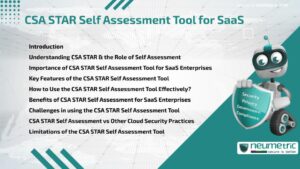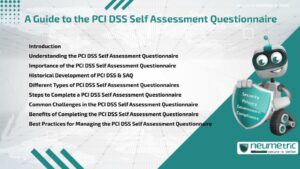Table of Contents
ToggleIntroduction
The PCI DSS Self Assessment Questionnaire is a validation tool that helps Organisations demonstrate Compliance with the Payment Card Industry Data Security Standard [PCI DSS]. It is primarily designed for Merchants & Service Providers who handle payment card data but do not require a full on-site Audit. By completing the Questionnaire, businesses can assess their Security Practices, identify weaknesses & prove adherence to PCI DSS requirements. This guide explains its purpose, types, benefits & challenges to help Organisations navigate the process effectively.
Understanding the PCI DSS Self Assessment Questionnaire
The PCI DSS Self Assessment Questionnaire [SAQ] is a structured set of questions based on PCI DSS requirements. It allows businesses to self-evaluate their Data Security Controls, such as Encryption, Access Management & Network Monitoring. Organisations complete the SAQ annually & submit it to their acquiring bank or card brand if required. It is a crucial step in ensuring Cardholder Data is protected without necessarily undergoing an External Audit.
Importance of the PCI DSS Self Assessment Questionnaire
The PCI DSS Self Assessment Questionnaire is important because it ensures businesses of all sizes can validate Compliance cost-effectively. For smaller merchants, the SAQ serves as an alternative to complex Assessments, making Compliance more accessible. It also helps businesses proactively identify Gaps in their security systems. Without the SAQ, Organisations may overlook Vulnerabilities that could lead to Breaches, Fines or Reputational damage.
Historical Development of PCI DSS & SAQ
PCI DSS was introduced in 2004 by major card brands such as Visa & Mastercard to standardise Payment Security practices. The PCI DSS Self Assessment Questionnaire followed as a simplified method for smaller businesses to demonstrate Compliance without hiring external Auditors. Over time, the SAQ has been refined alongside updates to PCI DSS, reflecting new Risks such as evolving Malware & Phishing attacks. Today, the SAQ remains an essential part of the PCI DSS ecosystem.
Different Types of PCI DSS Self Assessment Questionnaires
There are several types of PCI DSS Self Assessment Questionnaire formats tailored to different business models:
- SAQ A: For Merchants outsourcing all payment processing.
- SAQ A-EP: For E-commerce Merchants relying on Third Party Providers but managing their own web pages.
- SAQ B: For Merchants using imprint machines or standalone terminals without electronic data storage.
- SAQ C-VT: For Merchants using virtual terminals connected to the internet.
- SAQ C: For Merchants using payment systems with internet connectivity.
- SAQ D: For all other Merchants & Service Providers not fitting the above categories.
Choosing the correct SAQ type is essential for accurate Compliance reporting.
Steps to Complete a PCI DSS Self Assessment Questionnaire
Completing the PCI DSS Self Assessment Questionnaire involves several steps:
- Identify the correct SAQ type based on business processes.
- Gather documentation on Policies, Procedures & Systems.
- Answer the Questionnaire honestly & thoroughly.
- Remediate any Gaps identified during the process.
- Submit the SAQ to the acquiring bank or card brand if required.
This process is similar to conducting a regular health checkup-diagnosing issues early prevents more serious problems later.
Common Challenges in the PCI DSS Self Assessment Questionnaire
Organisations often face challenges when completing the PCI DSS Self Assessment Questionnaire. These include difficulty identifying the correct SAQ type, lack of technical knowledge & underestimating the effort required. Smaller businesses may struggle with limited resources, while larger ones may face complexity in mapping data flows. Another challenge is ensuring that Compliance efforts are maintained throughout the year, not just during the Assessment period.
Benefits of Completing the PCI DSS Self Assessment Questionnaire
Completing the PCI DSS Self Assessment Questionnaire offers significant benefits. It helps businesses demonstrate Compliance with Industry Standards, which is often required by payment processors. It reduces the Risk of Data Breaches by highlighting Vulnerabilities. Compliance also strengthens Customer Trust, as Clients feel more secure sharing payment information. For many Organisations, the SAQ provides both a Compliance Tool & a Roadmap for better Security Practices.
Best Practices for Managing the PCI DSS Self Assessment Questionnaire
To manage the PCI DSS Self Assessment Questionnaire effectively, Organisations should follow Best Practices. These include training staff on Security Policies, Documenting all Processes & using Automated Tools to monitor Compliance. Conducting periodic Reviews ensures that practices remain aligned with PCI DSS requirements. Involving Senior Management reinforces Accountability & Commitment. Much like routine safety drills, regular practice ensures that Security Controls are reliable during real-world Incidents.
Conclusion
The PCI DSS Self Assessment Questionnaire is a practical tool for businesses to validate Compliance & improve Security without undergoing a full Audit. By selecting the right SAQ type, completing it honestly & addressing identified issues, Organisations can safeguard payment card data & maintain trust.
Takeaways
- PCI DSS ensures payment card Data Protection through defined Standards.
- The SAQ provides a simplified Compliance method for smaller businesses.
- There are multiple SAQ types tailored to different merchant models.
- Challenges include resource limitations & technical complexity.
- Benefits include reduced Risk, Compliance validation & Customer Trust.
FAQ
What is the PCI DSS Self Assessment Questionnaire?
It is a validation tool that allows Organisations to self-evaluate their Compliance with PCI DSS requirements for protecting Cardholder Data.
Who needs to complete the SAQ?
Merchants & Service Providers handling payment card data, particularly those not requiring an on-site Audit, typically complete the SAQ.
How often should the SAQ be completed?
The SAQ is usually completed annually, although businesses may perform additional reviews if significant changes occur.
What happens if a business fails the SAQ?
If Gaps are identified, the organisation must Remediate them before claiming Compliance. Failing to comply can result in fines or restrictions from card brands.
How do I know which SAQ type applies to my business?
The correct SAQ type depends on how your business processes payments & whether you store, process or transmit Cardholder Data directly.
Is the SAQ mandatory?
Yes, in most cases. Acquiring Banks & Card brands require the SAQ to validate Compliance with PCI DSS.
Can Small Businesses use the SAQ?
Yes, the SAQ was specifically designed to make Compliance achievable for smaller merchants who may not have the resources for external Audits.
Need help for Security, Privacy, Governance & VAPT?
Neumetric provides organisations the necessary help to achieve their Cybersecurity, Compliance, Governance, Privacy, Certifications & Pentesting needs.
Organisations & Businesses, specifically those which provide SaaS & AI Solutions in the Fintech, BFSI & other regulated sectors, usually need a Cybersecurity Partner for meeting & maintaining the ongoing Security & Privacy needs & requirements of their Enterprise Clients & Privacy conscious Customers.
SOC 2, ISO 27001, ISO 42001, NIST, HIPAA, HECVAT, EU GDPR are some of the Frameworks that are served by Fusion – a SaaS, multimodular, multitenant, centralised, automated, Cybersecurity & Compliance Management system.
Neumetric also provides Expert Services for technical security which covers VAPT for Web Applications, APIs, iOS & Android Mobile Apps, Security Testing for AWS & other Cloud Environments & Cloud Infrastructure & other similar scopes.
Reach out to us by Email or filling out the Contact Form…





